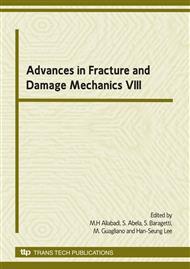[1]
Buyukozturk O., Nilson A.H., Slate F.O., Stress-strain response and fracture of a concrete model in biaxial loading, ACI Journal, August 1971, 590-599.
Google Scholar
[2]
Liu T.C.Y., Nilson A.H., Slate F.O., Stress-strain response and fracture of concrete in uniaxial and biaxial compression, ACI Journal, May 1972, 291-295.
DOI: 10.14359/7148
Google Scholar
[3]
Tasuji M.E., Slate F.O., Nilson A.H., Stress-strain response and fracture of concrete in biaxial loading, ACI Journal, July 1978, 306-312.
Google Scholar
[4]
Schlangen E., Van Mier J.G.M., Simple lattice model for numerical simulation of fracture of concrete materials and structures, Materials and Structures, 1992, 25, 534-542.
DOI: 10.1007/bf02472449
Google Scholar
[5]
Schlangen E., Garboczi E.J., �ew method for simulating fracture using an elastically uniform random geometry lattice, International Journal of Engineering Science, 1996, 34(11), 1131-1144.
DOI: 10.1016/0020-7225(96)00019-5
Google Scholar
[6]
Schlangen E., Garboczi E.J., Fracture simulations of concrete using lattice models: computational aspects, Engineering Fracture Mechanics, 1997, 57(2/3), 319-322.
DOI: 10.1016/s0013-7944(97)00010-6
Google Scholar
[7]
Dhir R.K., Limbachiya M.C., Leelawat T. Suitability of recycled concrete aggregate for use in BS 5328 designated mixes, Proceedings of the Institution of Civil Engineers-Structures and Buildings, 1999, 134(3), 257-274.
DOI: 10.1680/istbu.1999.31568
Google Scholar
[8]
Limbachiya M.C., Leelawat T., Dhir R.K., Use of recycled concrete aggregate in high-strength concrete, Materials and Structures, 2000, 33(2), 574-580.
DOI: 10.1007/bf02480538
Google Scholar
[9]
Ryu J.S., An experimental study on the effect of recycled aggregate on concrete properties, Magazine of Concrete Research, 2002, 54(1), 7-12.
DOI: 10.1680/macr.2002.54.1.7
Google Scholar
[10]
Topcu I.B., Sengel S., Properties of concretes produced with waste concrete aggregate, Cement and Concrete Research, 2004, 34(8), 1307-1312.
DOI: 10.1016/j.cemconres.2003.12.019
Google Scholar
[11]
Khatib J.M., Properties of concrete incorporating fine recycled aggregate, Cement and Concrete Research, 2005, 35(4), 763-769.
DOI: 10.1016/j.cemconres.2004.06.017
Google Scholar
[12]
Xiao J.Z., Li J.B., Zhang C., Mechanical properties of recycled aggregate concrete under uniaxial loading, Cement and Concrete Research, 2005, 35(6), 1187-1194.
DOI: 10.1016/j.cemconres.2004.09.020
Google Scholar
[13]
Xiao J.Z., Li JB, Zhang C., On relationships between the mechanical properties of recycled aggregate concrete: An overview, Materials and Structures, 2006, 39(6), 655-664.
DOI: 10.1617/s11527-006-9093-0
Google Scholar
[14]
Wu Y.C., Thompson E.G., Heyliger P.R., The compaction of aggregates of non-spherical linear viscous particle, Computer Methods in Applied Mechanics and Engineering, 2003, 192 4929-4946.
DOI: 10.1016/s0045-7825(03)00398-0
Google Scholar


